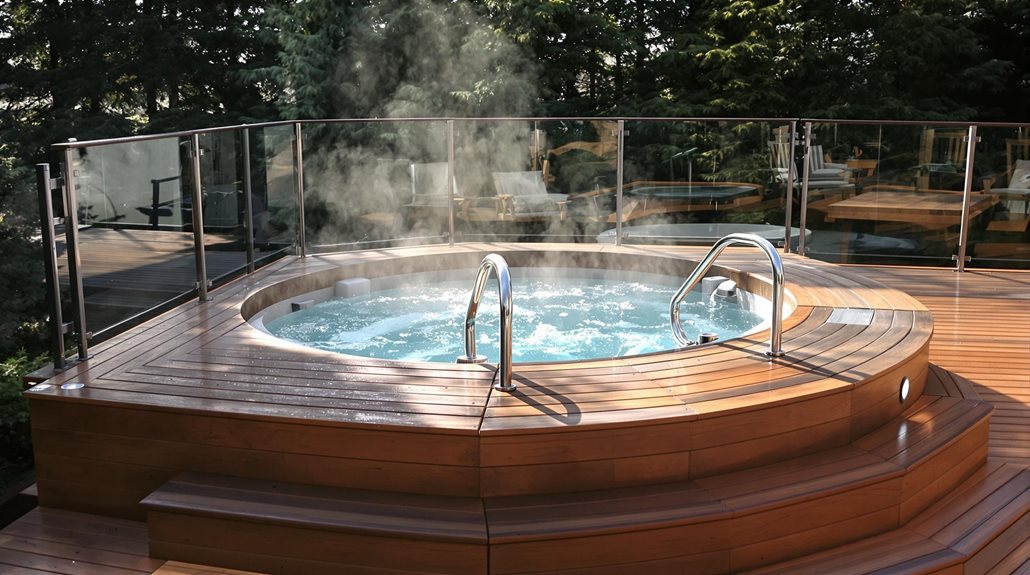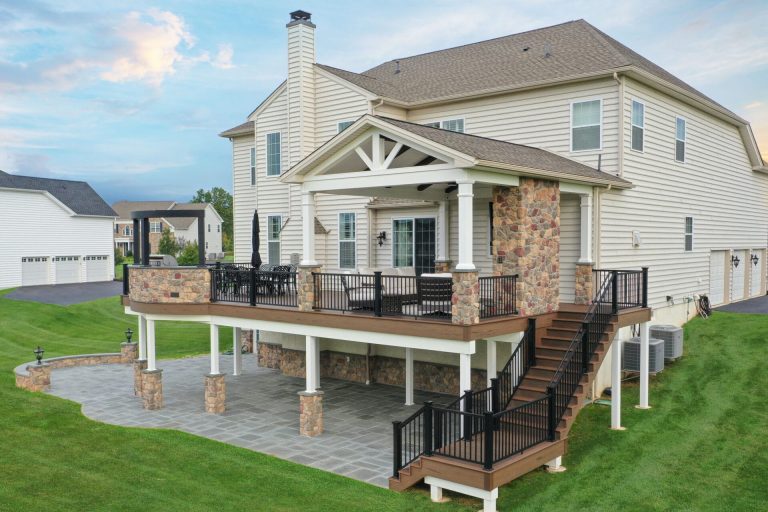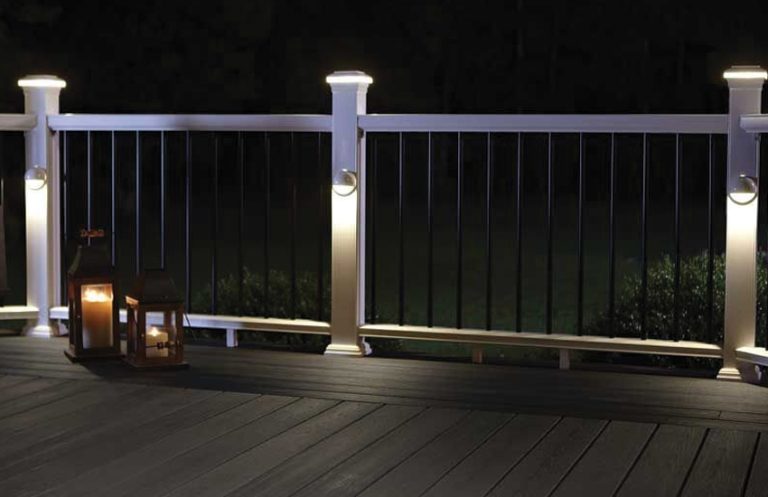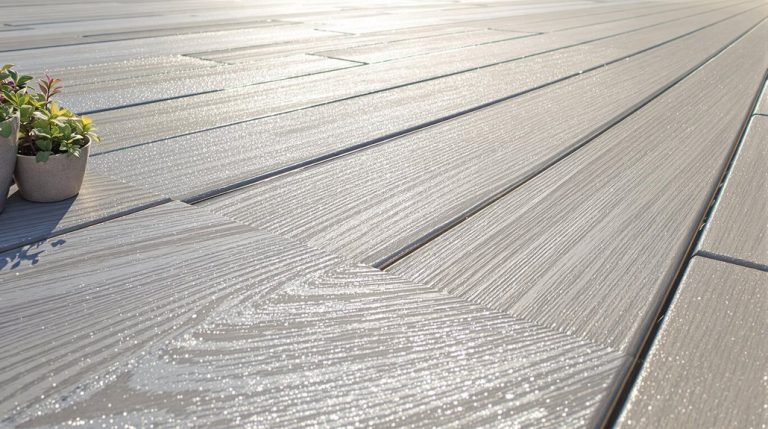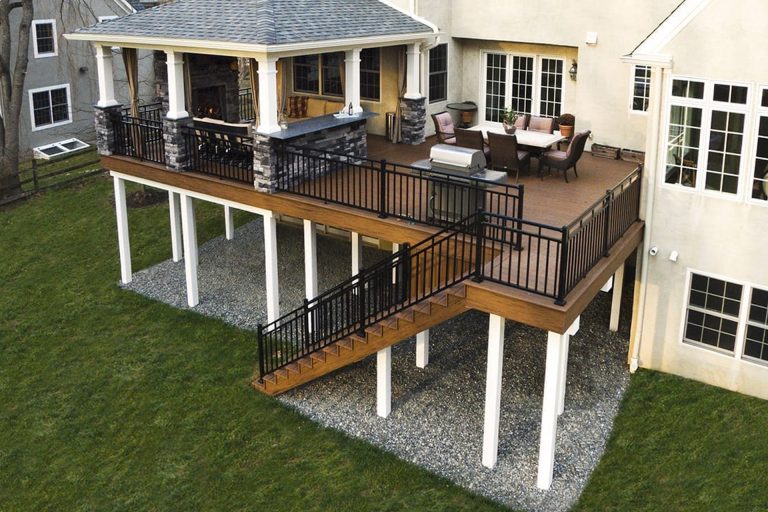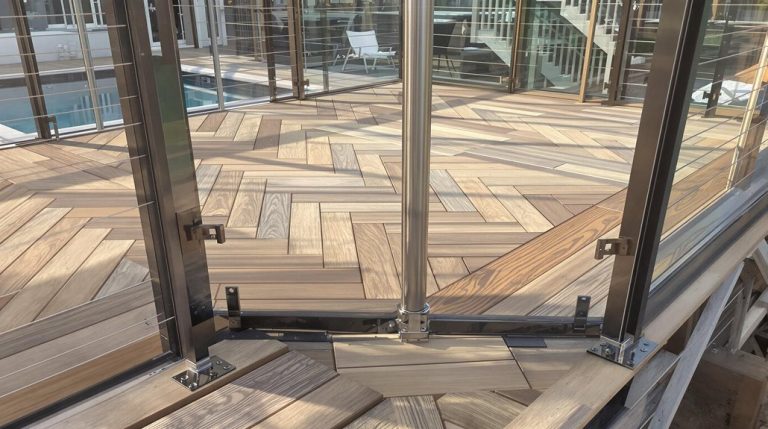Hot Tub Deck Integration: Essential Planning and Construction Guide
Integrating a hot tub into your deck poses significant structural, safety, and aesthetic challenges. To guarantee the deck's weight capacity, consult a structural engineer or contractor to inspect the foundation, joists, and beams for any wear or damage. Use pressure-treated lumber or durable materials like composite decking and hardwoods for stability. Design the layout carefully to maintain structural integrity and accessibility, incorporating non-slip decking and sturdy handrails. Properly integrate electrical and plumbing systems with waterproof components and insulate pipes to prevent freezing. By addressing these elements, you can create a safe and enjoyable outdoor space. Continuing with these guidelines will help you achieve a seamless hot tub deck integration.
Expert Highlights
- Evaluate the deck's weight capacity to ensure it can support the hot tub and occupants, consulting a structural engineer if necessary.
- Use durable and rot-resistant materials like pressure-treated lumber, composite decking, or natural hardwoods for the deck structure.
- Create a detailed blueprint of the hot tub layout, focusing on weight distribution and seamless integration with the existing deck design.
- Implement safety measures such as non-slip decking materials, sturdy handrails, clear pathways, and emergency access routes.
- Ensure all electrical and plumbing systems are waterproof, code-compliant, and properly insulated to prevent freezing and corrosion.
Assessing Deck Structural Integrity
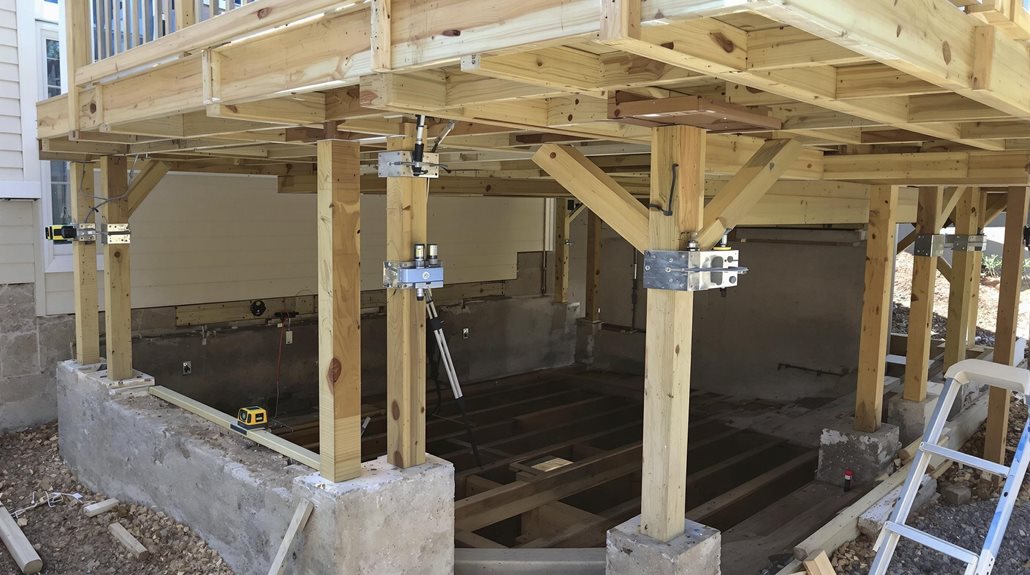
When integrating a hot tub into an existing deck, one of the most critical steps is evaluating the deck's structural integrity. The weight of a hot tub, filled with water and occupants, can be substantial and may exceed the original design capacity of the deck.
Failure to assess this can lead to catastrophic consequences such as deck collapse, injury, or even death.
To guarantee safety, homeowners should consult with a structural engineer or a qualified contractor to inspect the deck's foundation, joists, and beams. They should check for signs of wear and tear, rot, or damage.
If necessary, reinforcements like additional support beams or upgraded fasteners may be required. By taking these steps, homeowners can ensure their deck is sturdy enough to support the hot tub safely and enjoy their new installation without worry.
This precautionary measure not only protects property but also guarantees the well-being of everyone using the hot tub.
Our skilled craftsmanship ensures every structural modification meets the highest safety standards while maintaining your deck's aesthetic appeal.
Selecting Appropriate Materials
Selecting the right materials for your hot tub deck integration is a critical step that can significantly impact the durability, safety, and aesthetic appeal of your project. The wrong choice can lead to structural issues, maintenance headaches, and an uninviting appearance.
Sustainable deck materials contribute to eco-friendly outdoor living while maintaining exceptional performance standards.
- Pressure-Treated Lumber: Resistant to rot and insect damage, ideal for the structural frame.
- Composite Decking: Durable, low maintenance, and resistant to weathering and warping.
- Hardwoods: Such as cedar or redwood, offer natural resistance to decay and a rustic look.
- Synthetic Decking: Made from recycled materials, it is environmentally friendly and requires minimal upkeep.
These materials guarantee your deck remains stable, attractive, and safe over time.
Designing the Hot Tub Layout
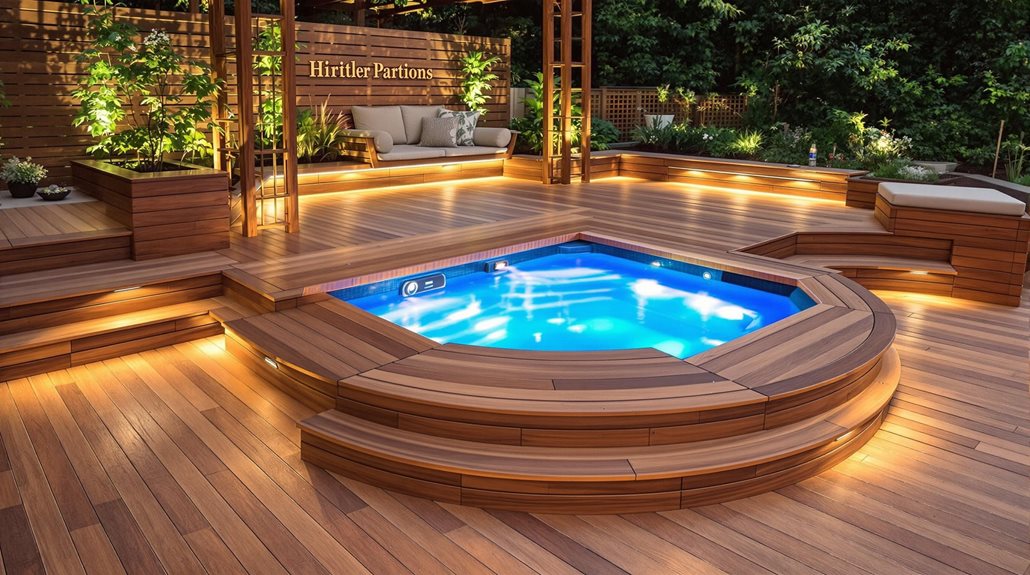
Designing the hot tub layout is an essential phase of your deck integration project, as it directly impacts both the functionality and aesthetic appeal of your outdoor space.
One of the primary challenges is guaranteeing that the hot tub fits seamlessly into the existing deck design without disrupting its structural integrity or visual harmony. To address this, it is imperative to measure the hot tub accurately and consider its weight distribution to avoid any potential structural issues.
Actionable solutions include creating a detailed blueprint that accounts for all dimensions and weights, as well as selecting a strategic placement that enhances accessibility and view.
This approach guarantees a balanced integration that not only supports the weight of the hot tub but also enhances the overall ambiance of your outdoor space. By doing so, you can create a cohesive and inviting area perfect for relaxation.
Working with licensed deck professionals ensures your hot tub installation meets all safety requirements and building codes while maintaining structural integrity.
Ensuring Safety and Accessibility
How can you guarantee that your hot tub deck integration project prioritizes both safety and accessibility? Securing these elements is vital to create an enjoyable and secure environment for all users.
Custom deck construction requires meticulous attention to detail for optimal safety outcomes.
- Non-Slip Surfaces: Install non-slip decking materials or apply textured coatings to prevent slipping, especially around the hot tub area.
- Handrails and Staircases: Confirm sturdy handrails are installed on staircases leading to the deck, and consider adding a gate at the top of stairs for added security.
- Clear Pathways: Maintain clear pathways around the hot tub to prevent tripping hazards and verify easy access.
- Emergency Access: Plan for emergency access routes in case of an accident, such as a wide enough path for a stretcher if needed.
Integrating Electrical and Plumbing Systems
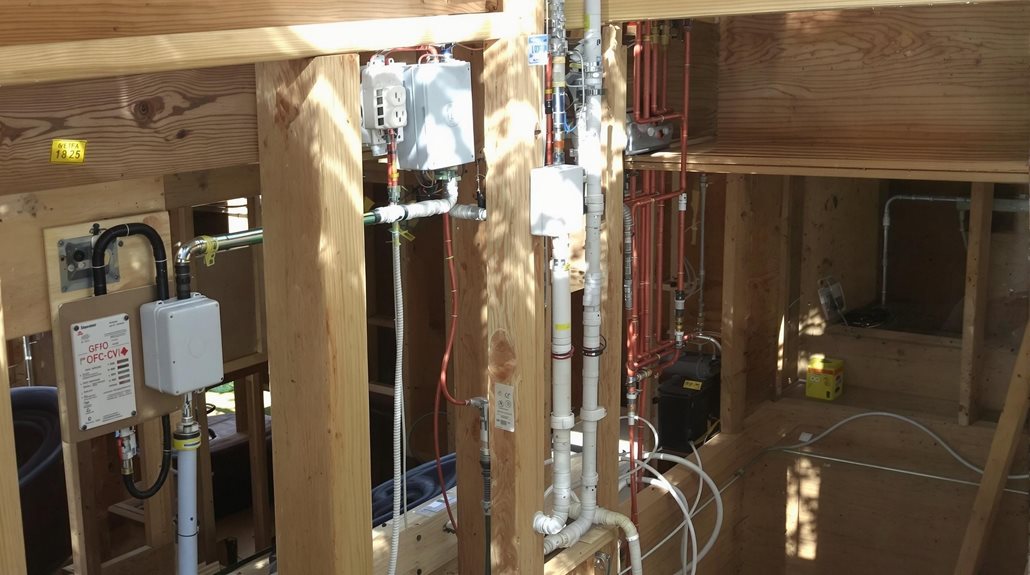
When integrating electrical and plumbing systems into a hot tub deck, several critical considerations must be addressed to ascertain both safety and functionality. One of the primary challenges is ascertaining that all electrical components are waterproof and installed in accordance with local building codes to prevent electrical shocks or fires.
This can be achieved by using GFCI (Ground Fault Circuit Interrupter) outlets and weather-resistant connectors.
For plumbing, it is essential to install pipes that can withstand the pressure and temperature fluctuations associated with hot tub use. Proper insulation of pipes and using materials like PVC or copper can help prevent freezing and corrosion.
Similar to our sustainable hardwood deck projects, all materials used must be carefully selected to endure exposure to moisture and temperature variations.
Frequently Asked Questions
How Often Should I Inspect and Maintain My Hot Tub Deck?
Regular inspections and maintenance of a hot tub deck are essential to guarantee safety and longevity. Check for rot, damage, and wear every 3-6 months, and perform annual thorough inspections to address any issues promptly.
Can I Install a Hot Tub on an Existing Deck Without Modifications?
Installing a hot tub on an existing deck without modifications is generally not recommended. The deck must be structurally sound and able to support the weight of the hot tub, water, and occupants. Professional assessment is essential to guarantee safety and durability.
What Are the Best Plants to Use Around a Hot Tub Deck?
For a hot tub deck, choose plants that are low maintenance, fragrant, and resistant to moisture. Options include lavender, rosemary, and succulents. These plants enhance the ambiance and require minimal care, ensuring a serene environment.
How Do I Protect My Deck From Mildew and Mold Near the Hot Tub?
To protect a deck from mildew and mold near a hot tub, guarantee good drainage, use mold-resistant materials, and regularly clean the area. Apply a waterproof sealant and maintain adequate ventilation to prevent moisture accumulation.
Can I Integrate a Hot Tub Into a Deck With a Slope or Uneven Surface?
Integrating a hot tub into a deck with a slope or uneven surface is possible but requires careful planning and execution. Ensuring the deck is structurally sound and level is essential to support the hot tub's weight and prevent damage. Customized framing and support systems may be necessary to achieve a stable surface. Consulting a professional contractor can help navigate these complexities effectively.
Expert Final Thougts
Integrating a hot tub into your deck requires meticulous planning and execution to guarantee both safety and enjoyment. Evaluating the deck's structural integrity is vital to support the weight of the hot tub and its occupants. Selecting appropriate materials, designing a thoughtful layout, and securing safe access are essential steps. Proper integration of electrical and plumbing systems completes the process. By following these guidelines, you can create a resilient and inviting hot tub deck that enhances your outdoor living experience while minimizing potential risks. This thoughtful approach assures a durable and enjoyable installation.

